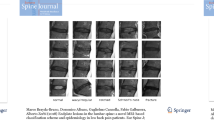Abstract
The evaluation of continued pain after a technically successful posterolateral lumbar spine fusion is often challenging. Although the intervertebral disc is often a source of low back pain, abnormal endplates may also be a focus of pain, and possibly a source of continued pain after a posterolateral fusion. MRI allows noninvasive evaluation for disc degeneration, as well as for abnormal endplates and adjacent vertebral body marrow. Previous studies have found inflammatory marrow changes, adjacent to abnormal endplates, associated with disc degeneration in low back pain patients. In this study, preoperative MRI scans in 89 posterolateral lumbar fusion patients were reviewed, by an independent radiologist, to determine whether vertebral body marrow changes adjacent to the endplates were related to contined pain. Independent chart review and follow-up telephone interview of all patients at a 4-year follow-up (mean) formed the basis for the clinical results. Vertebral body MRI signals consistent with inflammatory or fatty changes were found in 38% of patients, and always occurred adjacent to a degenerated disc. Inflammatory MRI vertebral body changes were significantly related to continued low back pain atP = 0.03. We conclude that posterolateral lumbar fusion has a less predictable result for the subset of degenerative disc patients with abnormal endplates and associated marrow inflammation. More research is needed to determine the biological and biomechanical effects of a posterolateral fusion upon the endplate within the fused segments. If indeed further study supports the hypothesis that abnormal endplates associated with inflammation are a source of pain, then treating the endplates directly by anterior fusion may be a preferred treatment for this subset of degenerative patients.
Similar content being viewed by others
References
Ahmed M, Bjurholm A, Kreicbergs A, Schultzberg M (1991) SP- and CGRP-immunoreactive nerve fibers in the rat lumbar spine. Neuroorthopedics 12:19–28
Ahmed M, Bjurhohn A, Kreicbergs A, Schultzberg M (1993) Neuropeptide Y, tyrosine hydroxylase and vasoactive intestinal polypeptide-immunoreactive nerve fibers in the vertebral bodies, discs, dura mater, and spinal ligaments of the rat lumbar spine. Spine 18:268–273
Blumenthal SL, Baker J, Dossett A, Selby DK (1988) The role of anterior lumbar fusion in internal disc disruption. Spine 13:566–569
Bogduk, N (1988) The innervation of the intervertebral discs. In: Ghosh P (ed) The biology of the intervertebral disc. CRC Press, Boca Raton, pp 135–149
Buttermann GR, Hunt AF, Garvey TA, Ogilvie JW, Transfeldt EE, Bradford DS, Boachie-Adjei O (1994) Results of lumbar fusion related to diagnosis (abstract). Ninth Annual Meeting of the North American Spine Society, Minneapolis
Crock HV (1986) Internal disc disruption - a challenge to disc prolapse fifty years on. Spine 11:650–653
De Roos A, Kressel H, Spritzer C, Dalinka M (1987) MR imaging of marrow changes adjacent to endplates in degenerative disk disease. Am J Radiol 149:531–534
Fedewa M, Schendel MJ, Buttermann GR, Transfeldt EE (1995) In vitro spinal endplate loading before and after fusion (abstract). Forty-first Annual Meeting of the Orthopaedic Research Society, Orlando
Feffer HL (1956) Treatment of lowback and sciatic pain by the injection of hydrocortisone into degenerated intervertebral discs. J Bone Joint Surg [Am] 38:585–592
Graham CE (1976) Chemonucleolysis: a double blind study comparing chemonucleolysis with intra-discal hydrocortisone in the treatment of backache and sciatica. Clin Orthop 117:179–192
Heggeness MH, Doherty BJ (1993) Discography causes end plate deflection. Spine 18:1050–1053
Hsu K, Zucherman JF, White AH, Wynne G (1987) Internal fixation with pedicle screws. In: White AH, Rothman RH, Ray CD (eds) Lumbar spine surgery. Mosby, St Louis, pp 322–338
Hsu K, Zucherman JF, Derby R, White AH, Goldthwaite N, Wynne G (1988) Painful lumbar end-plate disruptions. A significant discographic finding. Spine 13:76–78
Jackson HC, Winkelmann RK, Bickel WH (1966) Nerve endings in the human lumbar spinal column and related structures. J Bone Joint Surg [Am] 48:1272–1281
Kanemoto M, Hukuda S, Komiya Y, Katsuura A, Nishioka J (1996) Immunohistochemical study of matrix metalloproteinase-3 and tissue inhibitor of metalloproteinase-1 in human intervertebral discs. Spine 21:1–8
Kang JD, Georgescu HI, McIntyre-Larkin L, Stefanovic-Racic M, Donaldson WF, Evans CH (1996) Herniated lumbar inter-vertebral discs spontaneously produce matrix metalloproteinases, nitric oxide, interleukin-6, and prostaglandin E2. Spine 21:271–277
Kozak JA, O'Brien JP (1990) Simultaneous combined anterior and posterior fusion - an independent analysis of a treatment for the disabled low-back pain patient. Spine 15:322–328
Kuslich SD, Ulstrom CL (1990) The origin of low back pain and sciatica: a microsurgical investigation, chap 1. In: Williams RW, McCulloch JA, Young PH (eds) Microsurgery of the lumbar spine. Aspen, Rockville, pp 1–7
Lang P, Chafetz N, Genant HK, Morris JM (1990) Lumbar spinal fusion - assessment of functional stability with magnetic resonance imaging. Spine 15:581–588
Lauerman WC, Platenberg RC, Kluznik RP et al (1992) A naturally occurring primate model of disc degeneration: plain radiographic evaluation, MRI, and histopathologic correlation (abstract). Thirty-eight Annual Meeting of the Orthopaedic Research Society, Washington, DC
Leavitt F (1992) The physical exertion factor in compensable work injuries - a hidden flaw in previous research. Spine 17:307–310
Linson MA, Williams H (1991) Anterior and combined anteroposterior fusion for lumbar disc pain. A preliminary study. Spine 16:143–145
Liu J, Roughley PJ, Mort IS (1991) Identification of human intervertebral discs stromelysin and its involvement in matrix degradation. J Orthop Res 9:568–575
Maezawa S, Muro T (1992) Pain provocation at lumbar discography as analyzed by computed tomography/ discography. Spine 17:1309–1315
Melrose J, Ghosh P (1988) The noncollagenous proteins of the intervertebra] disc. In: Ghosh P (ed) The biology of the intervertebral disc. CRC Press, Boca Raton, pp 189–221
Modic MT, Steinberg PM, Ross JS, Masaryk TJ, Carter JR (1988) Degenerative disk disease: assessment of changes in vertebral body marrow with MR imaging. Radiology 166:193–199
Moneta GB, Videman T, Kaivanto K, Aprill C, Spivey M, Vanharanta H, Sachs BL, Guyer RD, Hochschuler SH, Raschbaum RF, Mooney V (1994) Reported pain during lumbar discography as a function of anular ruptures and disc degeneration. Spine 19:1968–1974
Pennington JB, McCarron RF, Laros GS (1988) Identification of IgG in the canine intervertebral disc. Spine 13:909–912
Perey O (1957) Fracture of the vertebral end-plate in the lumbar spine. An experimental biomechanical investigation. Acta Orthop Scand 25 [Suppl]: 22–101
Pritzker KPH (1977) Aging and degeneration in the lumbar intervertebral disc. Orthop Clin North Am 8:65–77
Rish BL (1984) A critique of the surgical management of lumbar disc disease in a private neurosurgical practice. Spine 9:500–504
Sedowofia KA, Tomlinson IW, Weiss JB, Hilton RC, Jayson MIV (1982) Collagenolytic enzyme systems in human intervertebral disc. Their control, mechanism, and their possible role in the initiation of biomechanical failure. Spine 7:213–222
Toyone T, Takahashi K, Kitahara H, Yamagata M, Murakami M, Moriya H (1994) Vertebral bone-marrow changes in degenerative lumbar disc disease. J Bone Joint Surg [Br] 76:757–763
Vellet AD, Marks PH, Fowler PJ, Munro TG (1991) Occult posttraumatic osteochondral lesions of the knee: prevalence, classification, and short-term sequelae evaluated with MR imaging. Radiology 178:271–276
Videman T, Nurminen M, Troup JDG (1990) Lumbar spinal pathology in cadaveric material in relation to history of back pain, occupation, and physical loading. Spine 15:728–740
Zdeblick TA (1993) A prospective, randomized study of lumbar fusion - preliminary results. Spine 18:983–991
Author information
Authors and Affiliations
Rights and permissions
About this article
Cite this article
Buttermann, G.R., Heithoff, K.B., Ogilvie, J.W. et al. Vertebral body MRI related to lumbar fusion results. Eur Spine J 6, 115–120 (1997). https://doi.org/10.1007/BF01358743
Received:
Revised:
Accepted:
Issue Date:
DOI: https://doi.org/10.1007/BF01358743




